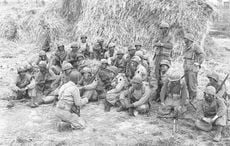Around 1,800 Irish men were held without trial at an internment camp in the remote village of Frongoch in north Wales following the 1916 Easter Rising.
According to The Irish Times, a “ghostly” railroad station in the tiny village is the last remaining evidence above ground of the camp.
“From the road, the house is just the first in a row of nondescript bungalows, set against a backdrop of Welsh woodland and the hills marking the edge of the Snowdonia national park. The back of the building, however, is startlingly different from the sloping gardens and washing lines of its neighbours: the signal box, station canopy, and platform of a halt on a long-vanished railway line still stand, shabby but remarkably well preserved,” writes The Irish Times.
Elwyn Edwards, a county councillor, historian, poet and Welsh language enthusiast, is one of the locals planning to mark the centenary of the village’s role in Irish history.
“This place still has a very strong atmosphere of the past,” he said, “for those with the patience to feel it, even though there is so little to see.”
Irish writer Val Mulkerns, 90, recently visited the place. Her father, JJ Mulkerns, was a prisoner in the camp.
“I never even knew there was a railway, but I always wondered how they all got here,” said Mulkerns. “It’s an eerie thought of them all arriving here, young men, far from home, packed in together, probably hungry and cold, frightened, not knowing what would happen to them.”
In 1914, an old distillery in the village was converted into a prison to hold German prisoners of war, and then emptied to hold the Irish, who in June 1916. The prisoners interned in the camp included farm boys and laborers, teachers, poets and artists, trade unionists and military strategists. Michael Collins was one of the Irish men imprisoned there.
Because most of the British soldiers were away fighting in the first World War, the camp was essentially run by the prisoners. The Irish Times reports that so many classes were organized at the camp that it became known as “ollscoil na reabhloide” — the university of the revolution. The prisoners were taught reading, writing, languages, and crafts, as well as military organization and discipline.
“It was here that the war of independence was won, before the men even went back to Ireland, ” Edwards said.
The camp closed in December 1916.
Because little physical evidence remains of the camp — the buildings were all demolished and the railroad was closed — many locals knew nothing of this particular history of their village until very recently.
“A year ago, a couple demolished a scruffy brick shed on the edge of their garden, and unwittingly destroyed the surviving guard post. A few stories were still told, of the farmer who fattened his pigs on swill from the camp, of the 16-year-old boy sent out by Collins to buy Welsh language text books, and the elderly guard who became so exhausted taking the men for a walk that the prisoners carried his gun back to camp for him,” writes The Irish Times.
However, interest in the camp’s history has grown in the village over the last few years, particularly since an Irish society in Liverpool installed a plaque as a memorial.
Frongoch now has plans to mark the 1916 centenary with wreath-laying ceremonies, flagpoles flying the Welsh and Irish flags, and informative panels explaining the history of the vanished buildings.




Comments